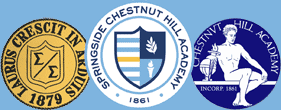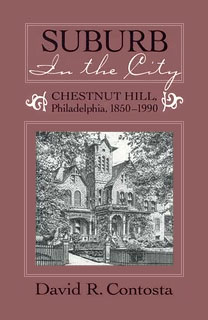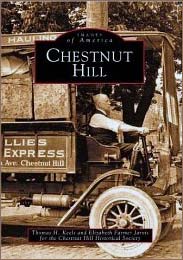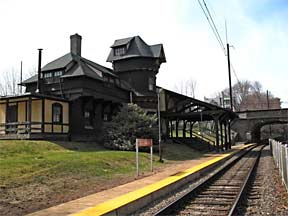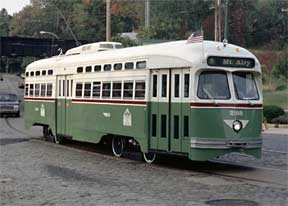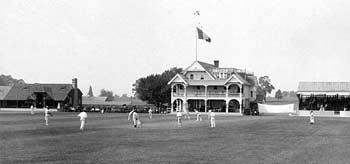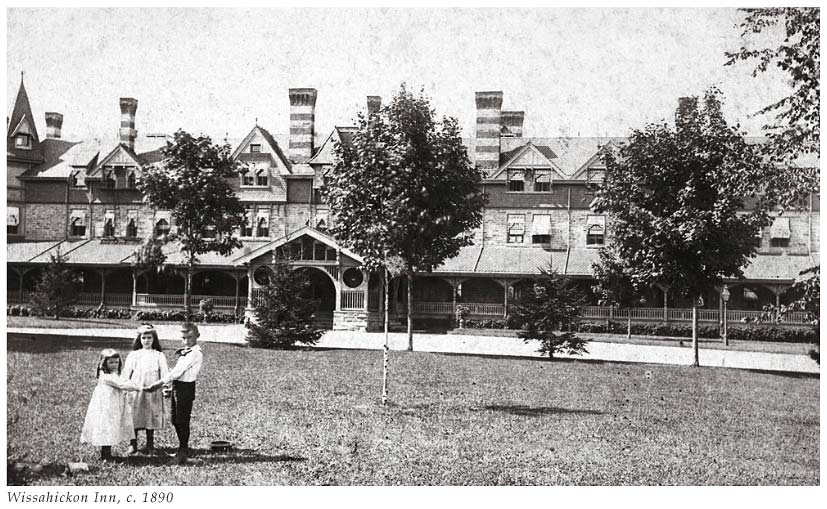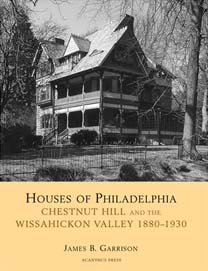Reunion
Scrapbook
A history of Chestnut Hill and our two schools
Whether we lived on "the Hill" or commuted from other townships to attend our two schools, the history of the village of Chestnut Hill, its people, and the buildings where we took our classes makes fascinating reading. Here we present a collection of materials which are sure to offer you greater historical insights about our old community.
SUBURB In the City
Chestnut Hill, Philadelphia, 1850–1990
by David R. Contosta
In Suburb in the City, David Contosta tells the story of how Chestnut Hill, Pennsylvania, once a small milling and farming town, evolved to become both a suburban enclave for wealthy Philadelphians and a part of the city itself.
In 1854, the railroad connected Philadelphia and Chestnut Hill, and the village was annexed by the city. Attuned to the romantic currents of the age, the wealthy men and women who moved to Chestnut Hill believed that the village's semi-rural surroundings might uplift them physically, spiritually, emotionally, and morally. At the same time, they wanted to continue to enjoy the best that the city had to offer while escaping from its more unpleasant aspects: dirt, crime, disease, and other shortcomings. They thus cultivated a dual identity with both suburb and city.
Ironically, this led to a sense of division as prosperous suburbanites held themselves aloof from the resident shopkeepers and domestic servants who provided so many of their creature comforts. Being a suburb in the city also meant that Chestnut Hill could not control its political destiny, as communities outside the municipal limits could. In response, residents developed a number of civic organizations that became a sort of quasi government.
Contosta's study of Chestnut Hill thus illuminates the divided and often ambivalent feelings that Americans hold about their great cities. He includes anecdotes gleaned from dozens of interviews with men and women of many backgrounds — lawyers, nuns, debutantes, grocers, craftsmen, and former servants — who tell of their lives in Chestnut Hill. More than one hundred photographs, many never before published, further enliven this analysis of suburban America.
Webmaster's note: Published by the Ohio State University Press (September 1995) in hardcover and paperback, this title is now out-of-print. Limited copies may still be purchased from selected merchants through Amazon.com's Marketplace and elsewhere. Happily, the entire 351-page volume – with full illustrations – is available free of charge to read online (or download to your computer) in PDF format, divided into 12 manageable documents ranging from 1.7MB to 9.6MB in size.
Images of America: Chestnut Hill (PA)
by Thomas H. Keels & Elizabeth Farmer Jarvis; Chestnut Hill Historical Society (Editor)
Chestnut Hill, in northwest Philadelphia, is one of America's most beautiful urban villages – thanks to the fusion of a magnificent physical setting, notable architecture, historic preservation, and careful planning.
During the Colonial period, Chestnut Hill was a rough-hewn village of farmers and millers. After the railroad reached the area in 1854, Chestnut Hill's natural splendor and healthful atmosphere made it a popular spot for Philadelphia's wealthy. Soon, it was ringed by magnificent estates designed by Frank Furness, T.P. Chandler, and Horace Trumbauer.
Living side-by-side with the wealthy were hardworking communities of Italian, Irish, and German immigrants. Chestnut Hill, a fascinating photographic record of the past, reveals some surprising secrets about this vibrant community. The current community center was once the site of a perpetual motion machine hoax that swindled nineteenth-century Philadelphians, and one local hotel provided liquor (and perhaps other illicit services) to Chestnut Hillers during Prohibition.
Stunning photographs and riveting stories of Chestnut Hill include those of the anti-Catholic Know-Nothings, who threatened to halt the construction of Our Mother of Consolation Catholic Church in the 1850s, and of Richard Norris Williams II, who survived the sinking of the Titanic and went on to win the national tennis championship twice at the Philadelphia Cricket Club.
About the Author
Historian Thomas H. Keels has written numerous articles for the Chestnut Hill Local and other newspapers. Elizabeth Farmer Jarvis is a curatorial consultant for institutions such as the Chestnut Hill Historical Society and the Atwater Kent Museum. She was museum curator at the Historical Society of Pennsylvania for nine years.
Chestnut Hill, Philadelphia, Pennsylvania
Boundaries
Chestnut Hill is bounded as follows:
- on the northwest by Northwestern Avenue (a county line and city limit, beyond which lies a panhandle of Springfield Township, Montgomery County that juts into Whitemarsh Township);
- on the west by the Wissahickon Gorge (part of Fairmount Park), beyond which lie Upper Roxborough and Andorra;
- on the northeast by Stenton Avenue (a county line and city limit), beyond which lie Erdenheim and Wyndmoor, Springfield Township; and
- on the southeast by the Cresheim Valley (part of Fairmount Park), beyond which lies Mount Airy.
ZIP code
The USPS does not officially correlate neighborhood names to Philadelphia ZIP codes (all are called simply "Philadelphia" or "Phila").[1] However, the 19118 ZIP code is almost entirely coterminous with the cultural-consensus boundaries of Chestnut Hill.
History
The village of Chestnut Hill was part of the German Township laid out by Francis Daniel Pastorius and came to include the settlements originally known as Sommerhausen and Crefeld, as well as part of Cresheim. It served as a gateway between Philadelphia and the nearby farmlands.
During the U.S. Revolutionary War era (late 18th century), the area was one of many summer vacation spots due to its higher elevation, 400-500 feet (120 to 150 m) above sea level, and cooler temperatures than the historic Center City. Chestnut Hill is still stereotypically known as one of the more affluent sections of Philadelphia. However, there are many residents who fall within lower/middle class incomes.
Chestnut Hill (along with many other towns and farmlands of Philadelphia County) became part of the City of Philadelphia in 1854 as part of the Act of Consolidation, when the County and the City became completely coterminous. In the same year, the Chestnut Hill Railroad opened, making an easy commute to and from Center City.
During the American Civil War, Chestnut Hill was home to Mower U.S. Army General Hospital, constructed to serve Union army soldiers.
From the mid-19th century through the mid-20th, the neighborhood served as the functional equivalent of both a "railroad suburb" and a "streetcar suburb" of Center City; although it was part of Philadelphia, and not a suburb, it was a leafy outlying part functioning much like a commuter town. (It still serves this function, although the streetcars are gone.) The neighborhood contains a wide variety of 19th and early 20th century residential buildings by many of the most prominent Philadelphia architects.
Architecture and housing stock
Housing in Chestnut Hill is considered expensive for this region. According to a 2013 study released by the Pew Charitable Trusts, the 19118 zip code had a median home sale price of $395,000 in 2010 and $401,250 in 2012 (+2%) – the highest of any Philadelphia neighborhood outside of Center City.
Redfin.com estimated a median listing price of $515,000 in Chestnut Hill during the 90 days ending 11/24/2013. BlockShopper.com reported a foreclosure rate of 0.97% in Chestnut Hill for 2013, or five out of 2,275 homes.
On July 1, 2013, the property at 8872 Towanda Street (a three-story single-family home built in 1908; 9,000 sq. ft. on 1 acre) was purchased for $1,800,000 by Joseph G. Grasso and Rosalie L. Hunter. It had belonged to Georges Perrier, chef and owner of Le Bec Fin, a five-star rated restaurant in Philadelphia which closed in 2013 after 43 years; Perrier had paid $2.4 million for the house in January 2008.
A contemporary home of more 'modest' proportions (4,820 sq. ft. on 2.02 acres) at 609 W. Gravers Lane – adjoining the Philadelphia Cricket Club – was listed for $1,975,000 in November 2013 with Berkshire Hathaway HomeServices Fox & Roach, Realtors.
Trulia.com reported the highest property taxes for a single-family home of $32,878/year on the 10,988 sq. ft., 3.08-acre property at 8870 Towanda Street, built in 1925. It was reportedly sold in August 2008 for $3.2 million by survivors of Charles Woodward. (See article: Woodward of Chestnut Hill: The Last Of Philadelphia's Feudal Lords.)
Among the historic and notable properties located in Chestnut Hill are:
- Esherick House (204 Sunrise Lane), designed by Louis Kahn.
- Vanna Venturi House (8336 Millman Street), designed by Robert Venturi.
- The former site of Boxly (515 West Gravers Lane), the estate of Frederick Winslow Taylor, where Taylor often received the business-management pilgrims who came to meet the "Father of Scientific Management".
- Inglewood Cottage (150 Bethlehem Pike), designed by Thomas Ustick Walter.
- See more historic properties here.
Median Income and Poverty Statistics
According to the Pew study, Chestnut Hill had the second highest median income within Philadelphia city limits ($80,950) after Society Hill in Center City ($93,222) – and the lowest percentage of residents living in poverty (5.8% versus 7.1% in Society Hill).
Public transportation
Public transportation in southeastern Pennsylvania, which includes Philadelphia and the surrounding counties, is provided by SEPTA, the region's mass transit authority.
Regional rail [commuter rail]
Two SEPTA Regional Rail lines serve Chestnut Hill: the R7 (Chestnut Hill East and Gravers stations) and R8 (Chestnut Hill West, Highland, and St. Martins stations).
Buses
Chestnut Hill is served by SEPTA bus routes from both the City Transit Division (23, 77 and L) and the Suburban Division (94 and 134).
Trolleys [trams]
Trams in the southeastern Pennsylvania region are known as trolleys. The trolley network of this region was very extensive prior to World War II, but has shrunk since that era. Trolley service to Chestnut Hill began in 1894, and trolley tracks still run down the Belgian-block-paved main street of the neighborhood, Germantown Avenue. SEPTA "temporarily suspended" regular trolley service in 1992.
The withering of trolley service in Philadelphia is generally unpopular with most residents. This topic generates heated emotions because it is related to the larger issue of the Great American streetcar scandal. Further discussion of the arguments and counterarguments is beyond the scope of this article.
Education
Colleges and universities
Chestnut Hill College (2013 enrollment: 1,541)
Primary and secondary schools
Public education
Residents are zoned to schools in the School District of Philadelphia. Students in grades kindergarten through 8 are zoned to John Story Jenks School, while students in grades 9 through 12 are zoned to Germantown High School.[2]
Private education
Chestnut Hill is home to many private schools, including Chestnut Hill Academy, Springside School, The Crefeld School (formerly The Stevens School), Norwood-Fontbonne Academy, and Our Mother of Consolation.
Many "Chestnut Hillers" also send their children to private schools in nearby neighborhoods such as William Penn Charter School, Germantown Friends School, Germantown Academy, Saint Joseph's Preparatory School, Abington Friends School, LaSalle College High School, and Mount Saint Joseph Academy.
Public libraries
Free Library of Philadelphia operates the Chestnut Hill Branch at 8711 Germantown Avenue.[3]
Parks and arboretums
- Pastorius Park
- Wissahickon Valley portion of the Fairmount Park system
- Morris Arboretum
Other notable civic institutions
- Woodmere Art Museum
- Philadelphia Cricket Club
- The Institutes for the Achievement of Human Potential is adjacent to Chestnut Hill in Wyndmoor
Religious institutions
- Chestnut Hill Seventh-day Adventist Church
- Chestnut Hill United Church
- Cresheim Valley Church (worships in Chestnut Hill Academy's chapel)
- Our Mother of Consolation
- The Presbyterian Church of Chestnut Hill
- St. Martin-in-the-Fields Episcopal Church
- St. Paul's Episcopal Church
On the National Register of Historic Places
- The Anglecot (designed by Wilson Eyre) – 401 E. Evergreen Avenue.
- Chestnut Hill Historic District
- Compton Historic District (Morris Arboretum: part of Compton & Bloomfield Historic District)
- Druim Moir Historic District (includes romanesque revival mansion built in 1883)
- Graver's Lane Station (designed by Frank Furness) – 300 block E. Gravers Lane.
- John Story Jenks School (designed by Irwin T. Catherine) – corner of Germantown and Southampton Avenues.
- Thomas Mill Bridge (across the Wissahickon Creek, the only traditional covered bridge in Philadelphia)
- Wissahickon Creek
- Wissahickon Inn (now Chestnut Hill Academy)
Notable residents (past and present)
- R. Tucker Abbott, malacologist and author
- Willie Anderson, golfer, winner of four U.S. Opens
- E. Digby Baltzell, author and sociologist
- James Bond (ornithologist) and namesake of the fictional secret agent
- Joseph S. Clark, former senator from Pennsylvania
- George Gordon Meade Easby, great-grandson of General George Meade
- Melissa Fitzgerald, actress
- William J. Green, III, former mayor of Philadelphia
- Henry H. Houston, railroad businessman and developer
- W. Thacher Longstreth, former City Councilman At-Large
- David Morse, actor
- Frank Rizzo, former mayor of Philadelphia
- Witold Rybczynski, architect and urban policy scholar
- Hugh Scott, U.S. Congressman and Senator
- Denise Scott Brown, architect
- Frederick Winslow Taylor, engineer, management theorist, and consultant
- Marcus Tracy, professional soccer player with Danish club AaB
- Robert Venturi, architect
- Alexander Lawton Mackall, journalist, editor, and gastronomic expert
- Lori Shorr, Chief Education Officer for Philadelphia
Quote by Frank Rizzo when he was Philadelphia's police commissioner: "When I'm finished with them [the demonstrators], I'll make Attila the Hun look like a fag." Trivia: During Rizzo's reign, police vans were colored red and known as "meat wagons".
References
[1] ^ USPS "Find All Cities in a ZIP Code".
[2] ^ "A Directory of High Schools for 2009 Admissions". School District of Philadelphia. Accessed November 6, 2008.
[3] ^ "Chestnut Hill Branch". Free Library of Philadelphia. Accessed November 7, 2008.
External links
Chestnut Hill Community Association
Chestnut Hill Business Association
Chestnut Hill College
Chestnut Hill Historical Society
The Chestnut Hill Local - newspaper
Germantown Avenue Parents - family resources and activities
John Story Jenks School - public school
Retrieved from "http://en.wikipedia.org/wiki/Chestnut_Hill,_Philadelphia,_Pennsylvania"
Categories: Historic districts in the United States | Neighborhoods in Philadelphia, Pennsylvania | National Register of Historic Places in Philadelphia, Pennsylvania | Streetcar suburbs | Historic preservation | Historic districts in Pennsylvania
This page was last modified on 17 April 2010 at 18:28.
Text is available under the Creative Commons Attribution-ShareAlike License; additional terms may apply. See Terms of Use for details.
Wikipedia® is a registered trademark of the Wikimedia Foundation, Inc., a non-profit organization.
Druim Moir Historic District
(added to National Register of Historic Places 1979 - Philadelphia County - #79002318)
Also known as Houston Estate Historic District
Bounded by Fairmount Park, Cherokee St., Hartwell Lane and Valley Green Rd., Philadelphia
(475 acres, 6 buildings, 2 structures)
Historic Significance: Architecture/Engineering
Architect, builder, or engineer: G.W. & W.D. Hewitt, Robert Rodes McGoodwin
Architectural Style: Shingle Style, Other, Romanesque
Area of Significance: Architecture, Community Planning and Development
Period of Significance: 1875-1899, 1900-1924
See Druim Moir Historic District (Wikipedia entry), Druim Moir Castle (article), photo 1, photo 2, photo 3, and drawing 1 (ca. 1890).
Houses of Philadelphia: Chestnut Hill and the Wissahickon Valley, 1880-1930
(Suburban Domestic Architecture) (Hardcover)
by James B. Garrison (Author), William Morrison (Editor)
Winding its way southward through the Philadelphia communities of Chestnut Hill and Mount Airy, as well as the verdant rural countryside of Gwynedd, Whitemarsh, and Wyndmoor, the Wissahickon Creek flows through a region of both unsurpassed natural beauty and some of the nation's most exquisite residential architecture.
The marvelous landscape that attracted early travelers and settlers became the setting for glorious estates that celebrated the connection between the natural and the built environment. From the mid-19th through the mid-20th century, three generations of prominent regional and national architects designed houses that have endured as magnificent examples of their own time, and remain eminently livable homes to this day.
In Houses of Philadelphia: Chestnut Hill and the Wissahickon Valley, 1880-1930, author James Garrison documents an outstanding group of houses, illustrating the scope of development in the Wissahickon Valley and the talented architects who worked there. From Henry Houston's much altered Drum Moir to Edward Stotesbury's extraordinary Whitemarsh Hall, the book examines 40 properties in detail with over 300 archival and contemporary photographs, drawings, and floor plans.
Fully researched, cogently written, and beautifully produced, Houses of Philadelphia provides a tangible and vibrant record of the eloquent and prodigious design heritage of the Wissahickon Valley.
(Click on image to browse book full-screen)
Note: these are selected excerpts from the book, as made available by the publisher, Acanthus Press.
The Druim Moir estate, for example, has been omitted from this particular sampling.
Tours of Chestnut Hill's Private Homes
Webmaster's note: Several must-see online photo galleries of Chestnut Hill's elegant private homes have been assembled by Joe Minardi (who goes by the online moniker "Swinefeld") – just follow the links below. Each one is a highly recommended visit, offering huge, beautiful pictures in amazing detail – all seemingly taken on perfect sunny days.
You are invited to provide comments, particularly if you can identify which of the pictured houses were occupied by the families of our classmates (both CHA and Springside) back when. You're certain to recognize a few! Heck, I'll buy you a beer if you write me and identify five (5) homes by photo, street address, and CHA-SS '70 family.
Chestnut Hill Tours: Part1 (North Chestnut Hill & Environs), Part 2 (Wissahickon Heights/St. Martins & Environs),
Part 3 (Woodward Developments & Environs) | Part 4 (Ancient & Modern Chestnut Hill) |
Part 5 (The French Village & Environs) | Photobucket album
Chestnut Hill Related Links
Chestnut Hill: Demographics and statistical profile
Friends of the Wissahickon
Saint Martins Station Committee
Visit Philadelphia: Chestnut Hill
The Wissahickon Gorge
Sources: Wikipedia, the Free Encyclopedia; National Register of Historic Places; Chestnut Hill Historical Society; Philadelphia Trolley Tracks. Editing and added links contributed by Ian C. Mills.
